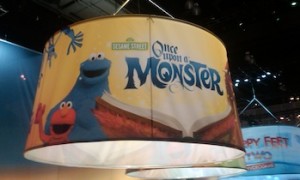 As an intern at the Joan Ganz Cooney Center, I was fortunate enough to attend the Electronic Entertainment Expo (E3) held on June 7-9. I was also able to partake in the 2nd annual Games and Learning Summit on the morning of June 7th, where a few dozen electronic industry leaders, top White House officials, philanthropic leaders from the Gates and MacArthur Foundations and academic experts such as James Paul Gee discussed the important role of game-based education in the rapidly growing world of digital technology. At the summit a few important questions were posed: Where exactly does education fit into the multimedia mix, and how can educational technology be created in an economically viable way for large electronic entertainment companies such as EA, Disney, and Sony?
As an intern at the Joan Ganz Cooney Center, I was fortunate enough to attend the Electronic Entertainment Expo (E3) held on June 7-9. I was also able to partake in the 2nd annual Games and Learning Summit on the morning of June 7th, where a few dozen electronic industry leaders, top White House officials, philanthropic leaders from the Gates and MacArthur Foundations and academic experts such as James Paul Gee discussed the important role of game-based education in the rapidly growing world of digital technology. At the summit a few important questions were posed: Where exactly does education fit into the multimedia mix, and how can educational technology be created in an economically viable way for large electronic entertainment companies such as EA, Disney, and Sony?
 After the summit, we were a given a tour of the new electronics products and platform innovations at the LA Convention Center where E3 was taking place. When I arrived I was amazed but overwhelmed; there were so many different games and electronic devices to look at and choose from. In fact, there were around 34,000 monitors for the 46,000 people that were there for the 3-day expo. Luckily we were on a guided tour so the overwhelming feeling soon subsided. We were first introduced to the EA booth where we were shown the newest video games, including Madden 12 and Battlefield 3. I was especially impressed to observe a number of army officers testing out and discussing Battlefield 3. I guess video games really are used to train our military!
After the summit, we were a given a tour of the new electronics products and platform innovations at the LA Convention Center where E3 was taking place. When I arrived I was amazed but overwhelmed; there were so many different games and electronic devices to look at and choose from. In fact, there were around 34,000 monitors for the 46,000 people that were there for the 3-day expo. Luckily we were on a guided tour so the overwhelming feeling soon subsided. We were first introduced to the EA booth where we were shown the newest video games, including Madden 12 and Battlefield 3. I was especially impressed to observe a number of army officers testing out and discussing Battlefield 3. I guess video games really are used to train our military!
Next, we visited Microsoft, where I had the honor of meeting Alex Kipman, the creator of Kinect, an innovative controller-free system on the Xbox 360 platform. He brilliantly explained how transformative the Kinect system is: it is able to read hand gestures, is personalized for each individual player, and can play multimedia content on demand instantaneously.
After leaving Microsoft, we visited a few more booths and were then encouraged to explore the rest of what the expo had to offer. As I spanned the almost five miles of carpeted floor, I observed thousands of gamers as they speedily and intensely traveled from one demo to the next. I always knew how much people relied on multimedia entertainment but observing it on such an intense level at E3 really allowed me to understand not only the power, but also the potential of the industry. I began to wonder whether there could be this much excitement about educational games and whether gaming companies could create multimedia that would be fun, educational, and successfully sell on the marketplace.
 In fact, as I continued to walk around the floor, I was surprised by how few educational games were on display. One game that caught my eye was Once Upon A Monster, which was created by Nathan Martz and Warner Bros. for Sesame Workshop. The game is aimed at 4-year-olds and is described as “an unforgettable and whimsical journey of discovery, learning, and fun.” Doesn’t that sound like the perfect mix for success?
In fact, as I continued to walk around the floor, I was surprised by how few educational games were on display. One game that caught my eye was Once Upon A Monster, which was created by Nathan Martz and Warner Bros. for Sesame Workshop. The game is aimed at 4-year-olds and is described as “an unforgettable and whimsical journey of discovery, learning, and fun.” Doesn’t that sound like the perfect mix for success?
In sum, the games and learning summit at the beginning of the week was definitely a nice push in the right direction. However, much work still needs to be done in order for educational multimedia to be viewed as engaging, effective in teaching children important skills, and a great business opportunity. If this is not accomplished, educational multimedia will cease to be seen as an important factor in the continually changing digital age.
Zachary Levine is an intern with the Joan Ganz Cooney Center this summer. He is a rising sophomore at the University of Wisconsin-Madison, where he is studying international relations. In summer 2010, he worked at E-line Media as a playtester for Gamestar Mechanic and during the Spring 2011 semester, he worked at the Morgridge Institute for Research as a playtester for a newly released iPad game called Virulent.
Photos by Zachary Levine



